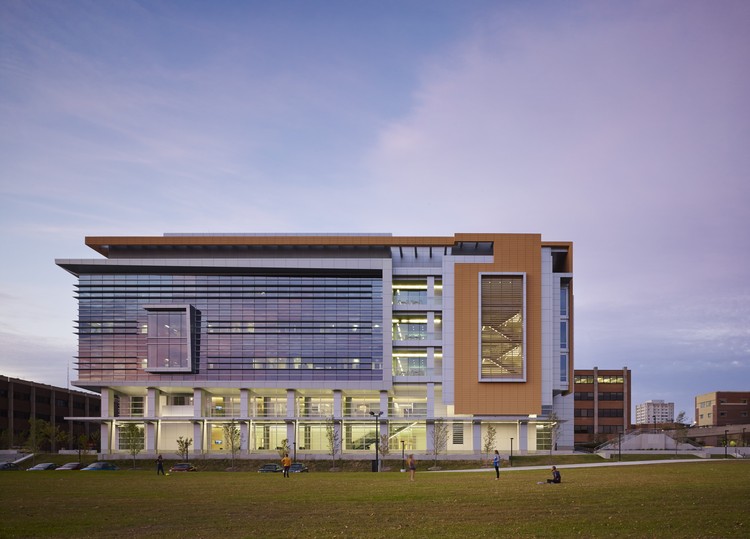
-
Architects: Flad Architects
- Area: 143500 ft²
- Year: 2015
-
Photographs:Steve Hall/Hedrich Blessing, Jeff Lendrum

Text description provided by the architects. Representing the UW-Milwaukee campus’ first new academic building in more than a decade, the Kenwood IRC houses academic and research space for STEM disciplines, provides space for the chemistry department including the Shimadzu Laboratory for Advanced and Applied Analytical Chemistry, serves as the new home for the physics department and includes labs for the Zilber School of Public Health. But its presence is being felt throughout the campus because of how it is sited and the way it is being used by so many different students.

UW-Milwaukee is an urban campus that was in need of state-of-the-art space for schoolwork and interaction. Students walking from parking to the heart of the academic center, student union and student housing would traverse an alley along the future IRC site and be funneled across the pedestrian overpass that is one of the few ways to quickly and safely cross North Maryland Avenue. Situating the building and designing it to take best advantage of prevailing conditions, Flad created a ground floor that serves as a pedestrian pathway, indoors and out. A loggia provides a covered walking path during warmer months, and helps efficiently route foot traffic from the student union to the east, through the site and beyond to the rest of the quad. The lobby, which accentuates the linear nature of the corridor’s east-west connection using horizontal channel glass, is the main thoroughfare throughout the colder months, as well as a magnet for students all school year long. Since its opening, the lobby has become a “third place” in students’ daily lives beyond home and the classroom.

The prominence of the lobby space within the building’s floor plan makes the IRC, technically speaking, an unusual hybrid. Floor slabs, lighting, ventilation and other building systems conform to the separate requirements of labs for the life sciences and physical sciences. For example, a below-grade core facility for condensed matter physics research was designed for sensitive instrumentation to protect equipment operation from the vibrations of passing city traffic. A communicating stair that links the third, fourth and fifth floors is an important connective element; its purpose, besides conveying people, is to offer opportunities for casual conversations and learning outside of formal settings.

The exterior expression of yellow terracotta, exposed concrete and metal panels is rendered as an assemblage of components, a metaphor for the research and innovation happening within. Dynamic and transparent, the building offers ample viewsof interior movement in the two-story lobby corridor and communicating stair, in addition to offices and instructional spaces on the upper floors.

An iconic building that offers researchers and students in the upper floors a spectacular view of downtown Milwaukee, the IRC maintains the connection between different areas of campus and creates a fresh palette of color and light as a template for future construction. The IRC has created a new brand for all of scientific research at UW-Milwaukee, and the campus as a whole.



















